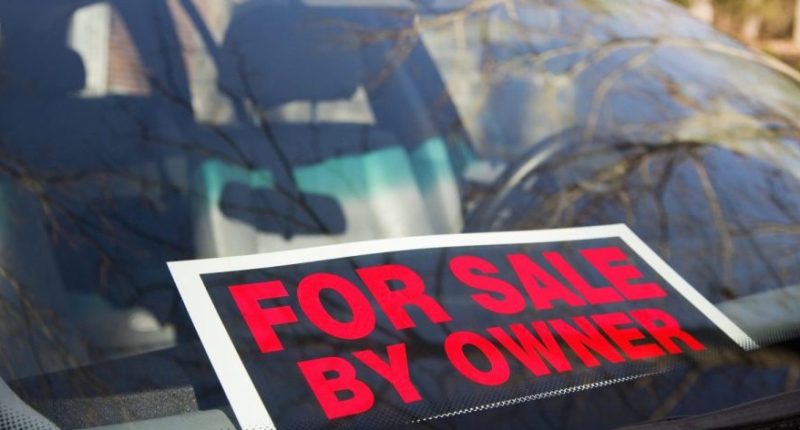Share this @internewscast.com

(iSeeCars) – Whether your vehicle is starting to show its age or a shift in life circumstances means you need a vehicle with different features, when the moment comes to pass your car to a new owner, several paths are available to you.
You could opt to trade your used car in at a nearby dealership. The advantage here is the simplicity and convenience this option offers. However, the drawback is that trade-in values at dealerships are typically the lowest you can get for your vehicle, since dealers need to resell your car, be it to another buyer or at an auction, while still maintaining a profitable margin.
Although it does require more effort, selling your car privately is far less complicated than it used to be, thanks to the modern tools available to consumers today. This guide will lead you through the process of selling your car on your own, aiming to clear up any confusion you might have about how to go about it.
Step One: Determine the Value of Your Car
Once upon a time, only dealers had access to industry valuation tools like the Kelley Blue Book price and a vehicle history report, two critical items when determining the best price for a car. Now anyone can access both items, along with a wide range of additional tools, as discussed below.
A vehicle’s market value and service history can be found through a variety of sources. iSeeCars.com offers its own Price My Car tool, as well as a comprehensive VIN Report (VIN stands for vehicle identification number), which combines both a market value assessment with a history of service, both customized to a specific vehicle based on its VIN. The iSeeCars VIN Report takes into account everything from local sales of similar vehicles to your car’s current odometer reading. It also provides an ownership history, recall history, and predicted depreciation over the coming 1, 3, and 5 years. These tools can help you confirm the right asking price for your vehicle.
Step Two: Organize Your Car’s Documentation
Once you know the value of your vehicle you can prep it for sale. The most important document you’ll need is your car’s title. If there’s a car loan on your vehicle you won’t have the vehicle title, which means you’ll need to work with the buyer and your lender on the title transfer once the car is sold. You should always tell prospective buyers the vehicle has a loan that has to be paid off early in the car sale process.
It’s pretty straightforward when selling a car with a loan on it, where a bank or financial institution holds a lien on the vehicle. You simply ask the lender for the exact pay off amount, which the buyer can provide to the lender with a cashier’s check, at which point the lender will release the title. The difference between the pay off amount and your car’s sales price is what you’ll have left after selling the vehicle, which the buyer can pay directly to you. A cashier’s check is among the most secure forms of payment, so feel free to require one from the buyer.
You’ll also want to gather all paperwork related to your vehicle. This includes any service records and warranty documentation you may have, as well as past registrations to confirm the vehicle’s history of use (feel free to redact personal information, like addresses and phone numbers, from these documents for your own peace of mind and privacy concerns).
Step Three: Advertise Your Vehicle
There are several options for finding potential buyers when it’s time to sell your car. You can advertise in local listings like your city’s newspaper website or Craigslist, or use national car marketplaces like Autotrader, Cars.com, Edmunds.com, and Facebook Marketplace. Each of them has a large audience and an interface that makes it easy to zero in on cars based on price, location, color, features etc.
Be sure you take plenty of photographs of your vehicle for the online ad, as these will increase the confidence for non-local buyers that can’t easily see the vehicle in person. While you shouldn’t invest too much money in a car you’re about to sell, spending some time and/or a small amount of money getting the vehicle cleaned up will improve your chances of getting your asking price.
Step Four: Working With Potential Car Buyers
Once your ad is live you should begin receiving inquiries from interested buyers almost immediately, assuming you did your homework and came up with a realistic asking price based on your car’s market value.
Many car sellers feel uncomfortable when it’s time to deal with potential buyers. This is understandable, and some basic security measures should be taken before meeting a buyer in person. For instance, if a buyer wants to see the vehicle, don’t meet at your house or in some random location, and never meet them at night. Meet them where other people are likely to be milling about, like outside a busy store, or where security cameras are likely to be in use, like a police station parking lot.
Feel free to bring a family member or friend along. The more the merrier! And if the buyer wants to take the car for a test drive, ask them to produce a valid driver’s license and auto insurance card first. Then ride with them on the test drive – never let them take the car on their own.
Step Five: Selling Your Car
You may have to negotiate the price with a buyer, but don’t be too quick to lower the price, especially if you’re still early in the sales process. If you valued your car properly, you should be able to find a buyer who will pay at or near your asking price.
Once you have a buyer ready to buy your car you’ll need a bill of sale to record the transaction.
A bill of sale states the car’s year, make, model and VIN, plus the buyer’s and seller’s name, the date of the transaction, and the selling price. Both the buyer and seller should sign the bill of sale and both should have a copy of it once signed.
As stated before, you’ll also need to sign over the vehicle title to the buyer, and if your title is held by a bank you’ll need the buyer to work with the lending institution to pay off the loan before the title is released. Meeting at the bank for the final transaction will make this process much easier, and even if you don’t have a vehicle loan the bank is a good place to transfer the title and receive the buyer’s funds, as you can verify the buyer’s form of payment before signing over the title.
In some states you’ll want to sign a release of liability form, which is a record of the car leaving your possession and transferring to a new owner. This protects you from any future liability issues related to the car. Similarly, in many states you will want to remove the car’s license plates and keep or destroy those, while in other states the license plate number stays with a car, even when ownership is transferred. Check with your state’s department of motor vehicles (DMV) to confirm which protocol is in place.
Additional Options
If you own a classic, special interest, or high-performance vehicle you may get a better price by using an auction site that specializes in these types of vehicles. Two prominent sites for these types of vehicles are Bring a Trailer and Cars & Bids. Both allow you to list your car in front of a large audience that’s likely to recognize and appreciate your vehicle, and if two or more people want your car the sale price can really skyrocket. We recently published an article comparing Bring a Trailer to Cars and Bids that will explain how they work in detail.
If you’re still not convinced about selling your car to a private party there are other, non-traditional dealership options to consider. You can sell your car to online retailers like Carvana. And if you’re combining your car selling process with the car buying process (a common pairing) you can use a non-traditional physical dealer like CarMax, which offers a network of stores across the country and a wide selection of cars and SUVs to choose from.
More from iSeeCars.com:
- How to Buy a Used Car
- How to Transfer a Car Title
- How Much is My Car Worth?
If you’re interested in a new or a used car to replace the vehicle you’re trading in or selling, be sure to check out iSeeCars’ award-winning car search engine . It uses advanced algorithms to help shoppers find the best car deals across all vehicle types and provides key insights and valuable resources, like the iSeeCars free VIN check report and Best Cars rankings. Filter by make, model, price, and special features to find the best deal on your next vehicle.
This article, How to Sell a Car, originally appeared on iSeeCars.com.

















